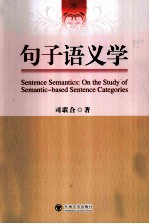

句子语义学PDF电子书下载
- 电子书积分:14 积分如何计算积分?
- 作 者:司联合著
- 出 版 社:南京:东南大学出版社
- 出版年份:2010
- ISBN:9787564125714
- 页数:412 页
Chapter One Introduction 1
1.1 Introduction 1
1.2 Lexical Semantics and Word Meaning 1
1.3 Sentence Semantics 7
1.3.1 Situation Types 8
1.3.2 Tense 10
1.3.3 Aspect 14
1.3.4 Mood and Modality 21
1.3.5 Voice 25
1.3.6 Thematic Roles 28
1.4 Sentence Meaning 37
1.4.1 Word Meaning and Sentence Meaning 37
1.4.2 Sentence Meaning and Utterance Meaning and Propositional Meaning 39
1.4.3 Sentence Patterns,Sentence Types and Sentence Categories 40
1.5 Significance of the Book 47
1.6 Methodology and Corpus 49
1.7 Organization of the Book 49
Chapter Two Interpretations of Sentence Meaning 51
2.1 Introduction 51
2.2 Katz'Semantic Theory 52
2.3 Montague Grammar 58
2.4 Leech's Semantic Structures of Sentences 63
2.4.1 Predications,Predicats,and Arguments 65
2.4.2 n-place Predicates 67
2.4.3 Predication Analysis 68
2.4.4 Subordinate Predication 69
2.4.5 Downgraded or'Featurized'Predication 70
2.5 Logical Semantics on Sentence Meaning 72
2.6 Jackendoff's Conceptual Semantics 79
2.7 Huang's Hierarchical Network of Concepts(HNC) 88
2.8 The Theoretical Framework of Sentence Meaning 90
2.8.1 Theoretical Framework 90
2.8.2 Huang's Hypothesis of Semantic Chunks and Sentences 93
2.8.3 Si's Hypothesis of Sentence Meaning 93
2.8.4 Expressions of Semantic Chunks 98
2.8.5 Semantic Situation Information 100
Chapter Three Preliminaries 105
3.1 Introduction 105
3.2 Semantic Chunks(including E chunk and JKs) 106
3.2.1 Constituents of Chunks 106
3.2.2 Types of Semantic Chunks 107
3.2.3 Semantic Chunks and Phrases 108
3.2.4 Constiuents of Sentences 110
3.2.5 Seven Sentence Categories 111
3.2.6 Concept Knowledge 114
3.2.7 E Chunk 118
3.2.8 JKs(juzi kuai) 124
3.2.9 How to Segment and Combine Chunks 128
3.3 Three Semantic Networks 139
3.3.1 Semantic Network of Primitive Concepts 141
3.3.2 Semantic Network of Basic Concepts 142
3.3.3 Semantic Network of Logical Concepts 142
3.4 Semantic Primitives 146
3.5 Semantic Structural Equation(SSE) 148
3.6 Linguistic and Philosophical Bases 153
3.7 Concepts 158
Chapter Four Simple Sentences 162
4.1 Introduction 162
4.2 Action Sentences(XJs) 166
4.2.1 General Action Sentences 166
4.2.2 Bearing Sentences 170
4.2.3 Reaction Sentences 184
4.2.4 Remitting Sentences 196
4.2.5 Binding Sentences 199
4.3 Process Sentences(PJs) 200
4.3.1 General Process Sentences 201
4.3.2 Basic Process Sentences 208
4.3.3 Sketch Sentences 212
4.3.4 Cause-effect & Effect-cause Sentences 214
4.4 Transfer Sentences(TJs) 218
4.4.1 Introduction 218
4.4.2 General Transfer Sentences 219
4.4.3 Substance Transfer Sentences 225
4.4.4 Informational Transfer Sentences 227
4.4.5 General Incept Sentences 231
4.4.6 Pertinent Incept Sentences 233
4.4.7 Transmitting Sentences 236
4.4.8 Self-transfer Sentences 241
4.4.9 Exchange Sentences 244
4.4.10 Substitute Sentences and Transformational Sentences 248
4.5 Effect Sentences(YJs) 251
4.5.1 Introduction 251
4.5.2 General Effect Sentences 252
4.5.3 Basic Effect Sentences 255
4.5.4 Bi-objects Effect Sentences 259
4.5.5 Action-effect Sentences 272
4.6 Relation Sentences(RJs) 277
4.6.1 Introduction 277
4.6.2 Bi-directional Relation Sentences 279
4.6.3 Extended Bi-directional Relation Sentences 281
4.6.4 Basic Main and Subordinate Relation Sentences 282
4.6.5 Extended Main and Subordinate Relation Sentences 285
4.7 State Sentences(SJs) 288
4.7.1 Introduction 288
4.7.2 General State Sentences 293
4.7.3 Basic State Sentences 296
4.7.4 Bi-permutation State Sentences 297
4.7.5 Tri-permutation State Sentences 298
4.7.6 Concise State Sentences 300
4.8 Decision Sentences(DJs) 306
4.8.1 Introduction 306
4.8.2 General State Sentences 306
4.8.3 Chunk-extended Decision Sentences 309
4.8.4 Basic Decision Sentences 310
4.8.5 Comparative Decision Sentences 316
4.8.6 Concise Decision Sentences 323
4.8.7 Concise Situational Decision Sentences 327
Chapter Five Multiple Sentences 328
5.1 Introduction 328
5.2 Compound Sentences 330
5.3 Complex Sentences 334
5.4 Mixed Sentences 348
5.4.1 Complex-Compound Sentences 348
5.4.2 Compound-complex Sentences 351
5.5 Summary 354
Chapter Six Conclusions 358
6.1 Contributions and Implications of This Research 358
6.2 Some Issues Worthy of Further Study 362
Bibliography 364
Appendix Ⅰ:List of Nodes for Concepts in Semantic Networks 375
Appendix Ⅱ:Expressions of Basic Sentence Categories 403
- 《剑桥国际英语写作教程 从句子到段落》(美)劳里·布拉斯(Laurie Blass),(美)德德拉·戈登(Deborah Gordon)编著 2019
- 《上海市订购外国和港台科技期刊联合目录 1983 上》上海科学技术情报研究所 1983
- 《上海市订购苏联情报出版物联合目录与索引 1983》上海科学技术情报研究所 1983
- 《基于C语言与Proteus联合仿真的单片机技术》丘利丽 2019
- 《数据空间中基于语义的实体搜索》杨丹著 2019
- 《联合作战指挥控制系统=COMMAND AND CONTROL SYSTEMS FOR JOINT OPERATIONS》蓝羽石 2019
- 《面向计算的词汇语义关系与语篇隐性连贯研究=A COMPUTATION-ORIENTED STUDY OF LEXICAL SEMANTIC RELATIONS AND TEXTUAL 》刘欣著 2020
- 《中国模拟联合国大会指导手册 最新版=A PRACTICAL GUIDE TO CHINA MATIONAL MODEL UN CONFERENCE (NEW EDITION)》中国联合国协会编 2019
- 《汉语动趋式的认知语义研究》周红著 2019
- 《语义学十讲》束定芳,田臻编著 2019
- 《中风偏瘫 脑萎缩 痴呆 最新治疗原则与方法》孙作东著 2004
- 《水面舰艇编队作战运筹分析》谭安胜著 2009
- 《王蒙文集 新版 35 评点《红楼梦》 上》王蒙著 2020
- 《TED说话的力量 世界优秀演讲者的口才秘诀》(坦桑)阿卡什·P.卡里亚著 2019
- 《燕堂夜话》蒋忠和著 2019
- 《经久》静水边著 2019
- 《魔法销售台词》(美)埃尔默·惠勒著 2019
- 《微表情密码》(波)卡西亚·韦佐夫斯基,(波)帕特里克·韦佐夫斯基著 2019
- 《看书琐记与作文秘诀》鲁迅著 2019
- 《酒国》莫言著 2019
